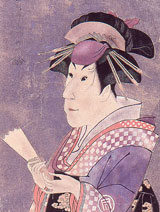
| A dynamic extension of the art experiences offered by the Telfair are special exhibitions from the collection and exciting traveling shows from all over the world. The Museum also offers a variety of stimulating programs for all ages, including hands-on youth activities in the Education Gallery, Evening Lectures, guided tours and Family Sundays. | |||||||||||||||||||||||||||||||||||||||||||||||||||||||||||||||||||||||||||||||||||||||||||||||||||||||||||||||||||||||||||||||||||||||||||||||||||||||||||||||||||||||||||||||||||
| Current |
CONTINUING THROUGH FEBRUARY 18, 2001 |
| LADIES, LANDSCAPES, AND LOYAL RETAINERS: JAPANESE ART FROM A PRIVATE COLLECTION |
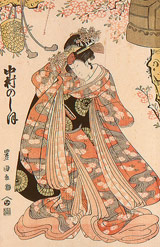 Evoking the rich cultural ambiance of Edo period Japan
(1615-1868), this memorable exhibition features classic ukiyo-e prints
depicting scenes from the "Floating World." These striking works explore
the majesty and intricacy of nature, the excitement of kabuki theatre, and
the fleeting delights of the pleasure districts, populated by elegant
geisha. Evoking the rich cultural ambiance of Edo period Japan
(1615-1868), this memorable exhibition features classic ukiyo-e prints
depicting scenes from the "Floating World." These striking works explore
the majesty and intricacy of nature, the excitement of kabuki theatre, and
the fleeting delights of the pleasure districts, populated by elegant
geisha.
Accompanying the prints are exquisitely crafted cabinet objects including sword fittings, articles of personal adornment, sake cups, and two painted screens. The traditional ukiyo-e themes of beautiful ladies, actors, landscapes, and nature are prevalent throughout. Part of a private collection assembled in Kyoto during the American
occupation, the show includes objects that have never before been publicly
displayed. Ladies, Landscapes, and Loyal Retainers will close February
18th. |
| LONG TERM LOAN |
| Acacia Collection of African Americana
|
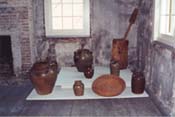 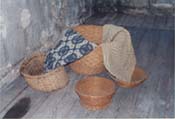 |
| Selected items on view at the Owens-Thomas House Urban
Slave Quarters. Organized by theAcacia Collection and the
Telfair Museum of Art. |
| Upcoming |
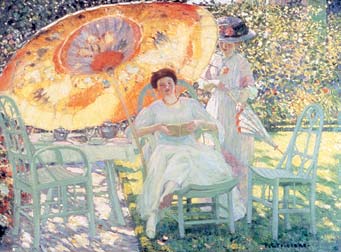 March 20 through June 3, 2001 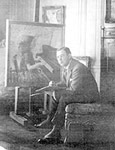 A millennium milestone will be celebrated on March 20th when
Frederick Carl Frieseke: The Evolution of an American
Impressionist, the largest and most comprehensive traveling exhibition
ever to be organized by the Telfair Museum of Art, opens in
Savannah.Almost four years in the making, the retrospective contains more
than 80 works and will travel to three other venues: the San Diego Museum
of Art, the Terra Museum of American Art in Chicago, and The Dixon Gallery
and Gardens in Memphis. Some of the works, deemed too fragile to travel,
are exclusive to the Telfair. A millennium milestone will be celebrated on March 20th when
Frederick Carl Frieseke: The Evolution of an American
Impressionist, the largest and most comprehensive traveling exhibition
ever to be organized by the Telfair Museum of Art, opens in
Savannah.Almost four years in the making, the retrospective contains more
than 80 works and will travel to three other venues: the San Diego Museum
of Art, the Terra Museum of American Art in Chicago, and The Dixon Gallery
and Gardens in Memphis. Some of the works, deemed too fragile to travel,
are exclusive to the Telfair.
Accompanying the exhibition will be a handsome 220-page full-color hardback catalogue published by the Telfair and distributed jointly with Princeton University Press. In addition, a 30-minute documentary with footage filmed in France, plus a charming children’s book illustrated by Savannah’s own Harriet Delong, and numerous special events complement the retrospective.
Frieseke’s early phase--from his arrival in Paris in 1897 until his move to Giverny in 1905--was influenced by the academic style favored in the Paris salons and the tonal approach of his famous teacher James McNeill Whistler. The Yellow Room (above) bears witness to this influence in its tonal arrangements and Japanese accessories.
Although Frieseke has often been described as "a painter of pretty
women," his principal concerns were actually sunlight and its varied
effects. In 1920 Frieseke moved his family to Normandy where he entered the final stage of his painting career. Returning to his early tonalist style, he adopted a more realistic approach while retaining his enduring interest in reflected light on the female form.
|
| JUNE 26 - AUGUST 26,
2001 |
| AFTER HISTORY: THE PAINTINGS OF DAVID BIERK |
| Organized by the Montgomery Museum of Art |
| JUNE 26 - AUGUST 26,
2001 |
| THE MAGICAL SELF: AFRICAN-AMERICAN HAIRDOS OF SAVANNAH |
| Organized by the Telfair Museum of Art (traveling) |
| SEPTEMBER 15, 2001 - JANUARY
2002 |
| ANDREW WYETH: CLOSE FRIENDS |
| Organized by the Mississippi Museum of Art |
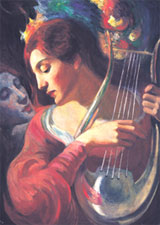 A treasured
and unique part of the Telfair’s permanent collection, Kahlil Gibran’s
evocative artwork is on display in the Drawing Room through February 18th.
Best known as the author of The Prophet, Gibran was born in
Lebanon. He immigrated with his family to Boston in 1895 when he was 12
years old. There he met the woman who would ultimately become his great
patron and lifelong friend, Mary Haskell. After she moved to Savannah,
Haskell (who married Savannah resident Jacob Florance Minis) donated over
80 of Gibran’s works to the Telfair, giving the museum the largest public
holding of his visual art in North America.
A treasured
and unique part of the Telfair’s permanent collection, Kahlil Gibran’s
evocative artwork is on display in the Drawing Room through February 18th.
Best known as the author of The Prophet, Gibran was born in
Lebanon. He immigrated with his family to Boston in 1895 when he was 12
years old. There he met the woman who would ultimately become his great
patron and lifelong friend, Mary Haskell. After she moved to Savannah,
Haskell (who married Savannah resident Jacob Florance Minis) donated over
80 of Gibran’s works to the Telfair, giving the museum the largest public
holding of his visual art in North America.
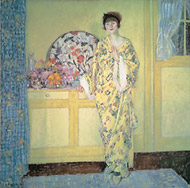 Recognized during his time as America’s best known painter
internationally, Frieseke is considered one of our country’s finest
Impressionists. In this retrospective, the full breadth of his genius will
be revealed through examination of the three phases of his artistic
evolution--from his early period, to his fully developed Impressionist
stage, to his later more realistic work.
Recognized during his time as America’s best known painter
internationally, Frieseke is considered one of our country’s finest
Impressionists. In this retrospective, the full breadth of his genius will
be revealed through examination of the three phases of his artistic
evolution--from his early period, to his fully developed Impressionist
stage, to his later more realistic work.
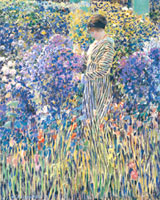 The second phase of Frieseke’s evolution--1905 to 1920--began
after he settled in Giverny, where he adopted a looser brushstroke and
lighter palette, working in the characteristic Impressionist style for
which he is best known. He became a dominant force in the Giverny Group, a
circle of expatriate American painters who lived and worked in this
picturesque French village and celebrated artists’ colony during the early
1900s, establishing as its primary theme the female figure in sunlit
gardens or intimate boudoirs. The exhibition will focus on many works from
Frieseke’s Giverny years, including Lady in a Garden and The
Garden Parasol (both pictured above).
The second phase of Frieseke’s evolution--1905 to 1920--began
after he settled in Giverny, where he adopted a looser brushstroke and
lighter palette, working in the characteristic Impressionist style for
which he is best known. He became a dominant force in the Giverny Group, a
circle of expatriate American painters who lived and worked in this
picturesque French village and celebrated artists’ colony during the early
1900s, establishing as its primary theme the female figure in sunlit
gardens or intimate boudoirs. The exhibition will focus on many works from
Frieseke’s Giverny years, including Lady in a Garden and The
Garden Parasol (both pictured above).
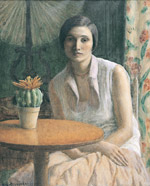 In his own words, "It is sunshine, flowers in sunshine;
girls in sunshine; the nude in sunshine, which I have been principally
interested in...If I could only reproduce it exactly as I see it I would
be satisfied."
In his own words, "It is sunshine, flowers in sunshine;
girls in sunshine; the nude in sunshine, which I have been principally
interested in...If I could only reproduce it exactly as I see it I would
be satisfied."